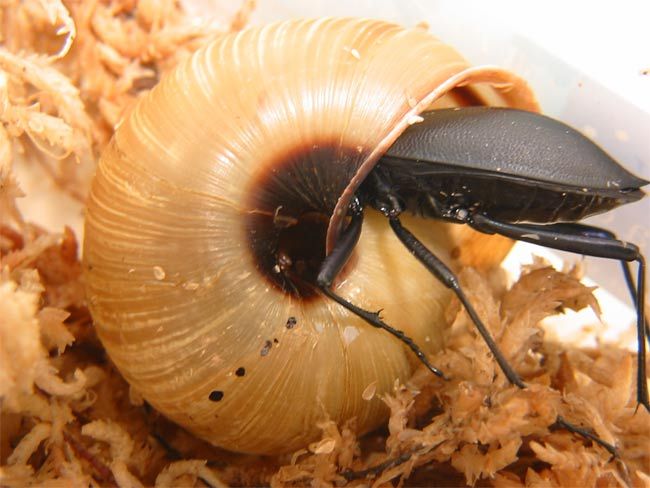Escargot Makes a Beetle's Head Swell

Beetle bodies come in two varieties: strong and stout, and extremely slender. Turns out, the distinct physiques make the beetles expert escargot feeders with distinct preferences.
Snail-feeding carabid beetles (Damaster blaptoides) living on the islands of the Japanese archipelago show either small or large heads, depending on the size of their mouths.
To find out how the extreme head sizes benefit the beetles, Junji Konuma and Satoshi Chiba of Tohoku University, located near Tokyo, conducted feeding experiments.
Big-headed beetles were too big to push into snail shells, so they relied on their powerful jaws to crush the shells. They chose snails housed in thin shells with small openings that were easier to demolish.
Beetles with small heads didn’t bother with the thin-shelled snails, as their jaws would be too weak to crush them. Instead they nosed their way into thick shells with large openings for some tasty escargot.
The findings indicate there is an evolutionary trade-off between the strong jaws that make for large heads and weak jaws that allow for smaller heads, a phenomenon the scientists call a trade-off between “force” and “fit.”
Beetles evolved to better consume snails, but snails also evolved to better elude the beetles, the thinking goes. And it is this evolutionary dance down through the ages that endowed predator and prey with their respective traits.
Sign up for the Live Science daily newsletter now
Get the world’s most fascinating discoveries delivered straight to your inbox.
“Trade-offs between force and fit have a significant, important role in both morphologies of snails and snail predators in evolution,” Konuma said.
The study is published in a recent issue of the American Naturalist.
- Image Gallery: Backyard Bugs
- Top 10 Amazing Animal Abilities
- Short a Testicle, Sexually Lopsided Beetles Still Do Their Thing
Jeanna Bryner is managing editor of Scientific American. Previously she was editor in chief of Live Science and, prior to that, an editor at Scholastic's Science World magazine. Bryner has an English degree from Salisbury University, a master's degree in biogeochemistry and environmental sciences from the University of Maryland and a graduate science journalism degree from New York University. She has worked as a biologist in Florida, where she monitored wetlands and did field surveys for endangered species, including the gorgeous Florida Scrub Jay. She also received an ocean sciences journalism fellowship from the Woods Hole Oceanographic Institution. She is a firm believer that science is for everyone and that just about everything can be viewed through the lens of science.











